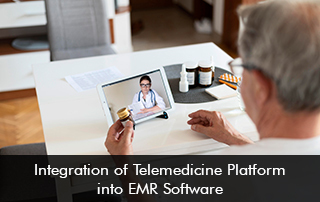Telemedicine and remote patient monitoring has been around since the 1960s, however since the global pandemic hit the world healthcare organizations started adopting Telemedicine EMR Software solutions like never before. The robust platform connects providers and patients in real-time and has helped to curb the spread of the virus by reducing patient traffic inside the doctor’s office. Telemedicine EHR software technology brings great benefits and it’s a good idea to integrate this technology to keep your practice growing.
Benefits of integrating Telemedicine software into the existing EMR software solution
The 2020 patient study revealed that 84% of patients are more prone to choose a healthcare provider that offers healthcare services via the telemedicine platform. Telemedicine software solutions offer great flexibility and convenience to patients and also eliminate the cost of traveling down to the clinic.
Some medical practices use both Electronic Medical Records (EMR) Software and a telemedicine system, this can be quite confusing and problematic. Hospital staff would need to manage and use two systems simultaneously which will add to workload pressure. When clinics integrate the telemedicine platform into their existing EHR Software system then workflows can be optimized and all patient records will be stored in one place which will streamline administrative and clinical workflows.
A good Telemedicine EMR software offers integration options with an existing EMR Software platform and is used in several care settings such as; community hospitals, physician practices, post-acute, surgery, and patient homes.
Considerations when integrating telemedicine into healthcare software
To make the Telemedicine software integration process as seamless as possible here are a few considerations to be taken.
EHR Software Standards
Integrating telemedicine means that practices are integrating data which isn’t as simple as it sounds as most hospitals in the US use the outdated HL7 v2 standard. Even if the existing Electronic Health Records software system uses the HL7 v2 standard the IT team would have to build integration layers to facilitate the EHR software system to exchange data from the telemedicine EMR Software system.
HIPAA Compliance
HIPAA Compliance is another key consideration to keep in mind. The HIPAA Compliance sets standards for the protection and encryption of patient data and information in the United States. It was recorded that in 2018 HIPAA violations cost healthcare organizations more than $28 million. Clinics and hospitals must comply with security rules to protect themselves from hefty costs and data breaches.
Essential Functionalities
To fulfill patient needs and improve remote care services here are a few important features that need to be present in your telemedicine module.
- HD video conferencing
- One-on-one HIPAA Compliant messaging platform for quick provider and patient communication.
- Self-scheduling and appointment reminders
- E-Rx
- Medical Billing
Final takeaway
Seamless integration of telemedicine software into existing EHR Software platforms can reduce costs and help streamline daily workflows. It is now essential to deploy telemedicine or telehealth solutions so practices can get the competitive edge and increase the revenue stream for improved financial health.






